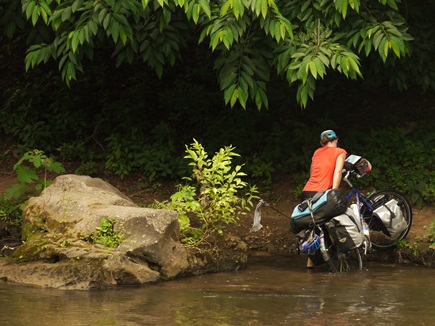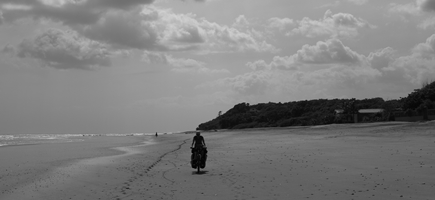Rediscovering our rhythm
July 8th, 2012
I don’t want to tempt fate but I am in a cheerful optimistic mood so I am going to say it anyway – we are both feeling much better. Parasites are either gone or dormant for now, hills are not quite so steep and the muscles in our legs are remembering how to turn the pedals on our bikes for six hours a day. We’re back in the swing of cycle touring. It seems like it’s been a long time since we felt like we had the remotest idea what we were doing….but you know what they say about riding a bike…
Our final days crossing Guatemala settled into a reassuring rhythm of filtering endless litres of water, sweating, preparing porridge and coffee as always for breakfast, sweating, climbing hills, drinking carton after carton of super sweet Central American chocomilk, sweating, climbing hills, and discussing latest bowel movements with a new cycling companion: Nathan. None of this is particularly interesting or glamorous, in fact some of it is entirely disgusting but it’s our familiar routine nevertheless and it feels good to be back.
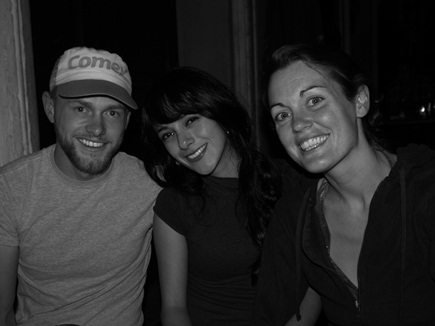
Before we left the comfort zone to return to an almost forgotten cycling trip we'd embarked upon, we went for drinks with my fantastic Spanish teacher Alma and our old cycling comrade Lee. He'd been in Xela a week longer than us and caught the Quetzaltenango bug, deciding to stay in town to teach English, salsa dance and generally put down roots for a while. We hope to see him along the road somewhere….
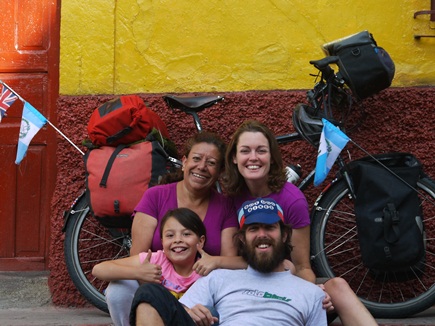
No more procrastinating, the two of us hit the road early on a Sunday morning, leaving behind our wonderful host family whilst we'd been at language school. Patti cooked us amazing food, encouraged my fledgling attempts at Spanish and gave us the warmest of Xela welcomes. We hope to return to her and her delicious tamalitos one day.
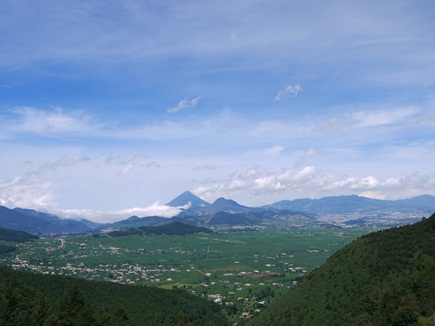
We set ourselves a fairly hefty target on the first day back on the bikes after a month, aiming to reach Lake Atitlan, more than 80km from Xela. We had sunny skies and the twin peaks of Santa María and Santiaguito to look back on as we climbed a short section on the Interamericana highway to its highest point, and then rolled down towards the lake picking up a police escort along the way.
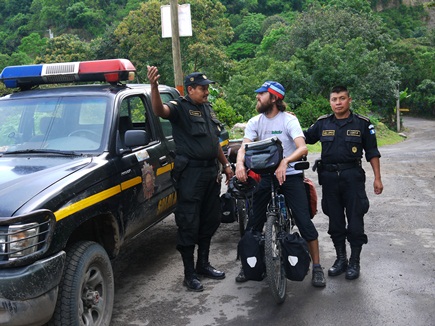
“I am arresting you for crimes against facial hair”…These guys were either bored on a Sunday afternoon or else genuinely concerned for the welfare of cycling tourists; whichever it was they did a thorough check on our details, sternly warned us that the road ahead could be dangerous and offered to escort us to the village on the the lake that we were headed for. We accepted their offer and sheepishly rode into San Marcos behind their cruiser.
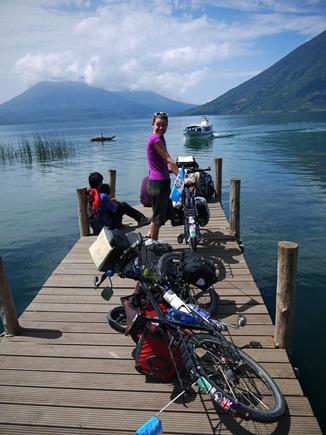
Movement between the villages and towns dotted around Lake Atitlan is easiest by lancha and so we prepared to throw the bikes onto one of these little boats and move on to Santa Cruz for our second day on the lake.
We arrived at Santa Cruz and checked in to a beautiful lakeside retreat called Arca de Noe, in sight of Volcan San Pedro. James had stayed here a few times more than ten years previously, whilst he was living in Guatemala City and remembered it as a peaceful, beautiful place.

He was right. The perfect place to sit amongst the flowers, sip strong coffee, gaze at the volcano, listen to the sounds of the lake and………..relax.
We liked Arca de Noe so much we couldn't help ourselves and stayed an unplanned extra day – thank you to my wonderful, generous family who put birthday presents into my bank account, you paid for our lovely second night here! We ate delicious homemade pasta made by the manager Christian, who is originally from Patagonia, and has kindly offered to hook us up with friends and family of his when we reach Argentina. We're already looking forward to meeting his contacts somewhere along the road.
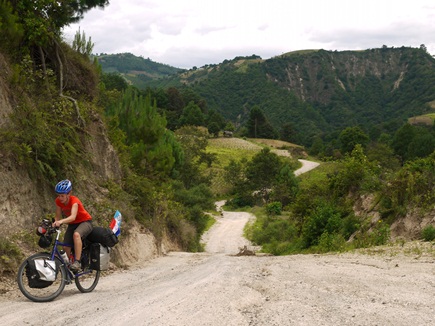
After our difficulties with dirt roads and hills before arriving in Xela, we decided to look the problem in the face and tackle a few on our way between Lake Atitlan and Antigua to make sure we hadn't become allergic.
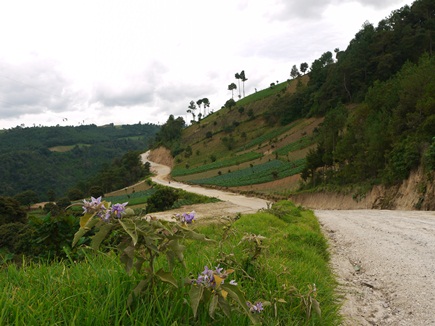
This great dirt track was perfect, tough but not too steep with beautiful views and then a great descent.
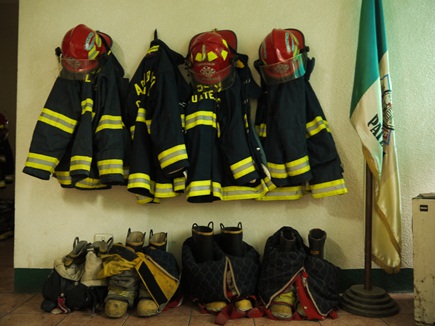
Reaching Patzicía, we found there were no cheap hotels but someone recommended we have a chat with the guys at the local fire station. Next thing we know we're all set up with a comfy bed in one of their dorms and use of their kitchen facilities….
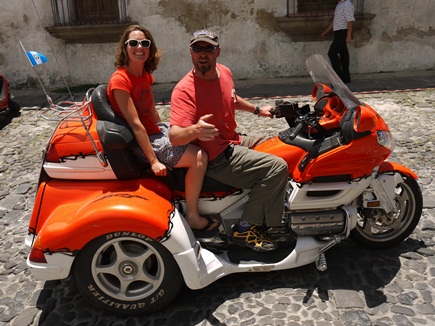
Arriving in Antigua, we went to find Dave, who James knew from his previous time in Guatemala; they volunteered at the same charity and then cycled from Guatemala City to Panama together. Dave now runs his own motorbike touring company out of Antigua and in his spare time, likes to zoom around on this crazy trike that he recently picked up from West Virginia. He's heading down to Colombia on it this summer, so we expect to be looking out for this orange beast along the road in a few weeks' time.
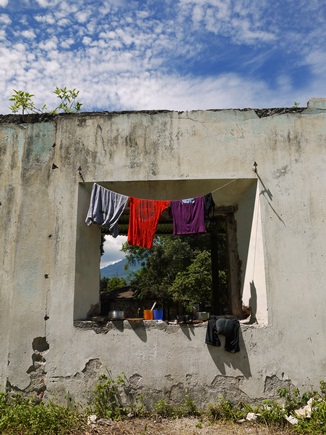
The tourist police compound in Antigua gave us chance to catch up on some washing, to dry out our stuff and enjoy some free camping in the heart of Guatemala's most touristy city.
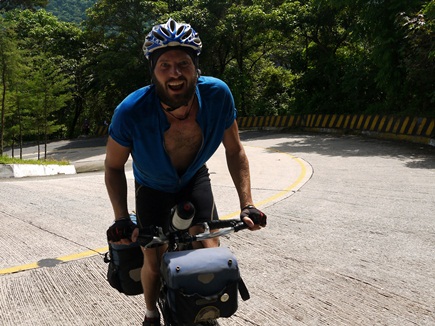
Joined now by Nathan, a British touring cyclist who we met in Xela, we left Antigua and set off with excitment towards the Honduras border…or so we thought. It was a lovely ride but our first day out of Antigua was a non starter. It saw us take a 10km wrong turn, and then be turned back on the correct road because it was too dangerous and so we ended up back in Antigua where we had started.
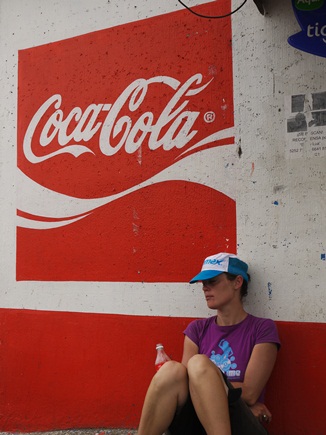
The next day everything went a little more smoothly and we took a long steady climb out of Antigua by a different road. Lunching on a roundabout, and fuelled by Coca Cola as always, we ended the day in a shabby hotel in San Juan Pinula, to celebrate Nate's birthday with takeaway pizza and a couple of cold Guatemalan beers.
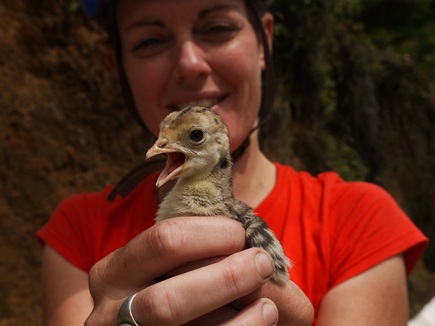
Climbing out of Mataquescuintla (yeah, try saying that after a few cans of Strongbow!), we found this turkey chick by the side of the road. He evidently thought he could fly and dropped off a high perch about ten feet above. Being a long time frustrated veterinarian, I scooped him up and returned him to his family.
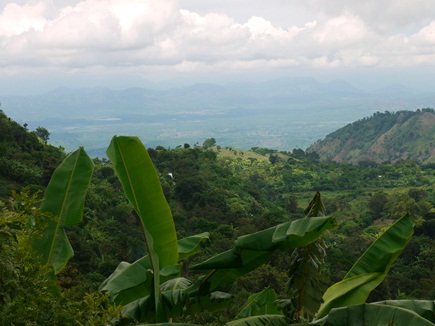
This corner of Guatemala, up in the mountains, is beautiful. Our days here were all about getting up early to beat the lunchtime heat, cycling up big hills, wowing at marvellous views, stuffing ourselves on pan dulce, setting up camp or finding a cheap hotels and then seeking out newly discovered hula hoops…they're almost as good as the ones back home, but to my dismay, unfortunately they don't come in salt and vinegar flavour.
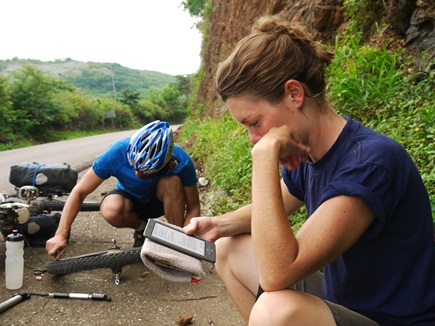
Our last day in Guatemala, headed for the Honduras border was going to be a big one and to make it we had to get up super early and couldn't really afford many stoppages or delays. Things didn't quite go to plan as punctures don't really tend respect your schedule; just half an hour into our ride, Nate found himself changing a puncture on the back wheel…while I helped out by reading my book…

Trying to get rid of the last of our Guatemalan Quetzales before we crossed the border, we bought some healthy and nutritious snacks: biscuits, an ice cream each and one more to share…I look worried because I am anticipating the terrible state of my teeth by the end of this trip if we keep up this routine of sugar based snacks.
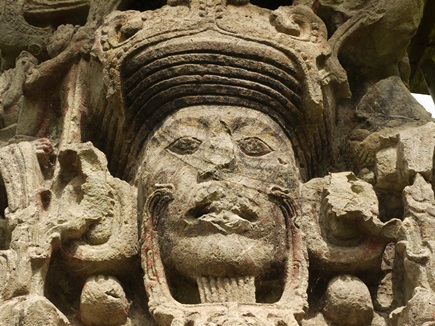
Once into Honduras, we visited the ruins at Copán. The site was peaceful and well preserved. The ruins date back to AD250-900 and amazingly the beautiful detail and hieroglyphics remain.
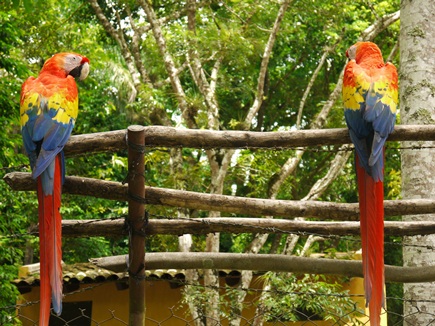
The site at Copán is also home to lots of noisy macaws who are making the transition from a nearby bird sanctuary back into the wild. The flashes of colour from their vibrant feathers as they flew past was a stunning addition to the lush green canopy of the woods around the ruins.
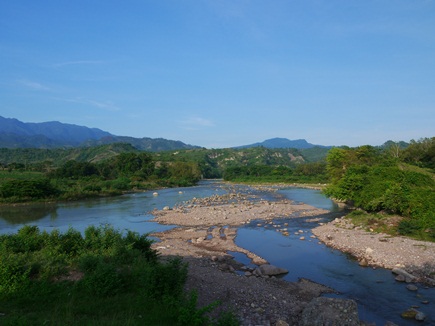
The journey between Copán and our next big-ish stop at Gracias was an undulating and pretty ride. Through valleys and over rivers like this one.
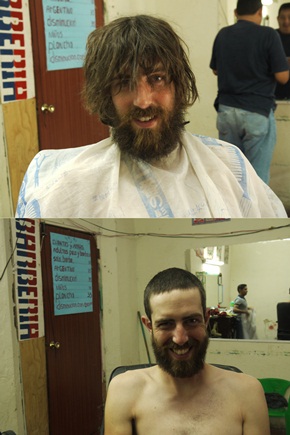
Once in Gracias, James, sufferng from the heat of Central America finally succumbed and visited the barber for the first time in the year to get his locks chopped off. Here are the obligatory “before and after” shots. All I can say is “…thank goodness for that!”
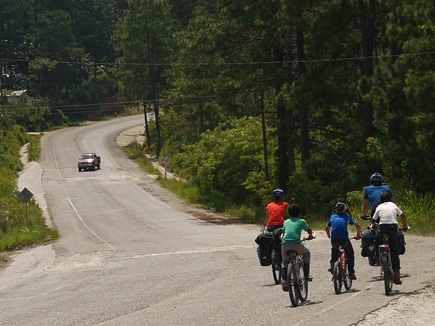
A hot and steady climb out of Gracias and into the rolling green countryside. Our morning break in this little village was witnessed by no less than seven local children, the shopkeeper, two dogs and a chicken. All watched us munch on bananas, gobble up biscuits and guzzle down Coke as usual and then we set off again, with Nate and I accompanied by the kids who escorted/raced us to the village border line – the local school.
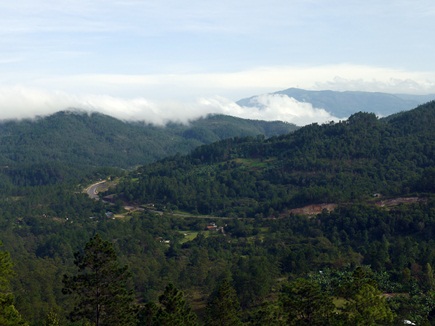
After an overnight stop camped in an ironmonger's workshop, we started a long climb up to Honduras' highest town, La Esperanza. Looking back at what we'd achieved halfway through the climb was a satisfying experience.

Unfortunately just a few minutes later, in what has also become part of our regular routine, and nastily interrupting the steady rhythm we'd acquired, we had stopped, removed my back wheel and set about fixing yet another puncture…this time thanks to a thin piece of wire on the side of the road that got stuck in my tyre.
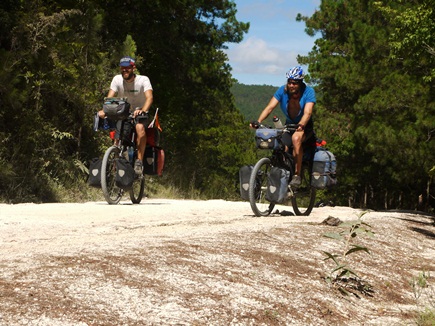
A couple of days relaxing in La Esperanza and we were off again on one of the most enjoyable roads we've ridden in a while. A dirt road took us away from town along a quiet back route to the border with El Salvador. It was of course hot but through beautiful pine forest with wonderful views. A ride to remember.
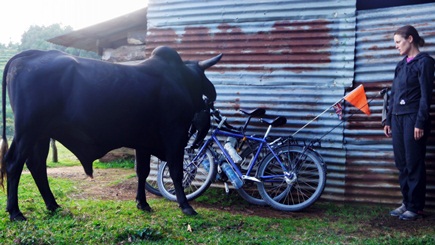
Close to the border we stopped at a military settlement for the night. The soldiers generously invited us to pitch our tents in their lovely grassy field without telling us that it was the grazing area for two very large bulls. This one took a keen interest in my bike, leaving a slobbering trail of drool all over my handlebars. I was not impressed and we slept with anxiety for fear of being trodden on in the night….
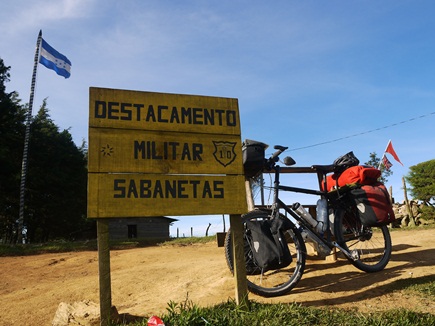
…thankfully, we woke safe the next morning, bid farewell to the soldiers (and the bulls) and set off for El Salvador.
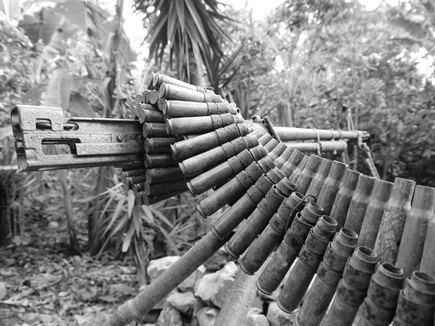
The border crossing was straightforward enough and we rolled into the nearby town of Perquín. Notorious as a base for guerilla troops during El Salvador's civil war, we visited a reconsutructed guerrilla camp for an introduction to this new country.

Little did we know that we'd only be spending 36 hours in El Salvador. We thought it would take us at least a day longer to make our short cut through the north east corner of the country but the roads were fast and either downhill or flat so we were through in no time. Thankfully our one and only morning there was a beautiful one with views of mountains and trees through clouds and sunshine.
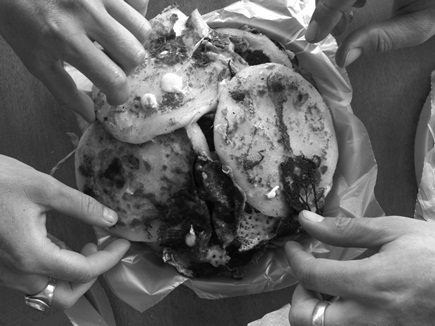
With such little time, we squeezed in as many of El Salvador's pupusas as possible. Maize dough stuffed with cheese…beans… or beans or cheese…or cheese and beans (spot the theme?) – then cooked on a hot plate; great for our raging hunger. We ordered a stack of them to share before crossing the border back into Honduras.

The short time we spent in El Salvador was a little confusing money wise as their official currency is US dollars so we were reintroduced to familiar notes unexpectedly…dollars are apparently also more commonly used in Costa Rica and Panama so we can expect to use them again soon.
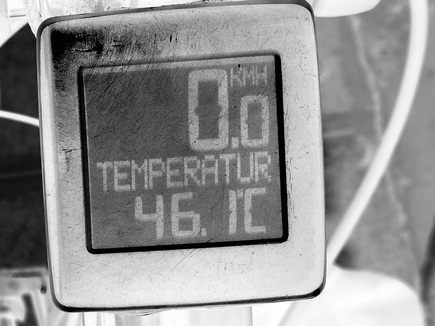
As I might have mentioned, we've been a bit hot. James' cycle computer confirmed what we already knew – just in case being drenched in sweat and eternally thirsty wasn't enough of a sign.
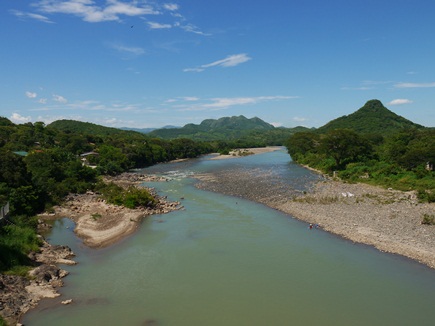
Back into Honduras from El Salvador and another crossing over another river – El Salvador on the left, Honduras on the right…
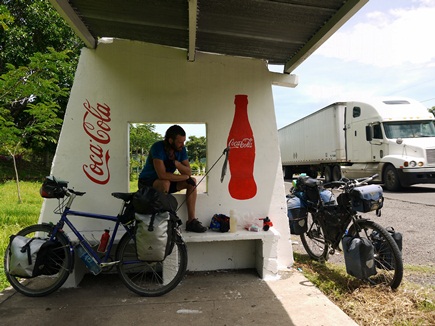
Our second time in Honduras was really mostly about making our way to Nicaragua. We had no option here but to take the Interamericana, the main route through Central America for heavy freight. The landscape has changed so much within the last week and now we're down at sea level and the roads are flat, busy, narrow and pretty boring….and of course hot! We searched for shade in bus stops and looked back to those dirt days in Guatemala and Honduras with fond memories.
Sarah
Nica beach cruising
July 15th, 2012
Riding the beach was something we’d long wanted to do on this trip – but so far it had never quite worked out.
Having battled the heat, trucks and tedium of the Interamericana for the previous few days on our dash across Honduras, we were keen to find an alternative route down through Nicaragua. And so, after a few days of rest and relaxation in León, Nicaragua’s revolutionary capital, we bid a sad farewell to Nate – who was off to the USA to buy some new tyres visit his girlfriend – and set off for the beach.
Our map showed a network of minor roads which in theory would allow us to keep west and track down the Pacific coast. On paper, it looked perfect – but not for the first time, our map was a triumph of optimism over the reality of Central American backroads. Gradually, the roads became rough tracks, then trails – and then disappeared entirely.
However – as has always been the case when we have given up on the map and relied on locals’ advice from village to village – it made for a memorable few days, and finally delivered our long-awaited fix of beach riding.
James
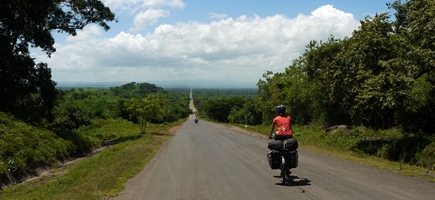
A welcome break from truck dodging – the almost deserted (and very straight) old highway from León to Managua. We followed this as far south as Santa Rita, where we turned off towards the seaside towns of Masachapa and Pochomil and stopped for lunch. We've learned that we always cycle better in the morning, and so the decision to stop to eat has turned into an epic battle of wills, as both of us fight to stave off the pre-lunch wobbles and churn out a few more km.
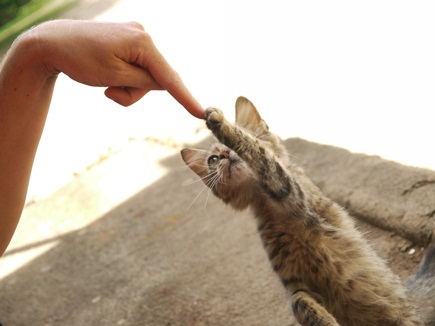
When one of us finally does crack, we fall into a heap at the side of the road – and almost always find a friend hoping for scraps. Needless to say, begging from hungry cyclists is very rarely profitable…
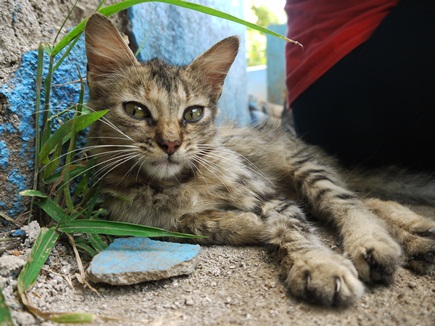
…even when you're this cute. If Bedders had her way, this guy would have been into her handlebar bag in a flash, and coming on a very long holiday.
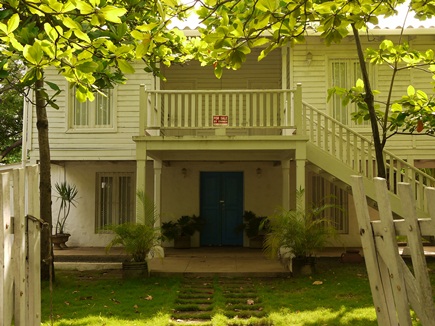
After a night in Masachapa, we headed along the coast to Pochomil. As the closest beaches to Managua, this stretch of coast used to be popular in the past with weekenders from the city, but with the rise of the more fashionable San Juan del Sur in the south it has a faded air. Desperate restaurant owners chased us along the beach for our business, and most of the luxurious beach-front homes like this one seemed to be up for sale.
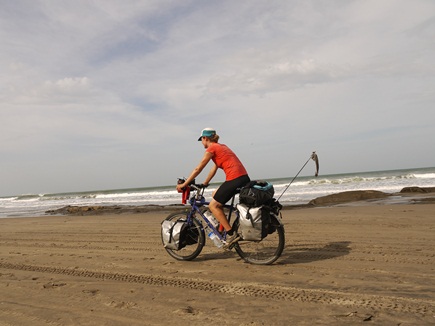
We started to ride the beach from Pochomil towards La Boquita – but were stopped by locals who told us with the tide coming in we would never make it across a deep channel which lay ahead. First lesson of beach riding – it's all about the timing.

Instead we cut inland, where we found a track which snaked its way through enormous sugar cane plantations and tiny coastal villages. Two friendly engineers from the plantation company on motorbikes stopped ahead at each junction to make sure we were headed on the right track.
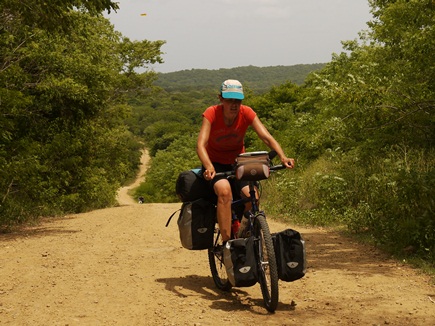
Remember Anneka Rice? Well let me introduce you to her Central America reincarnation: Anneka Rice and Beans. She's been revamped for a new eco-friendly generation, ditching the helicopter for a bike. She eats hills for breakfast…
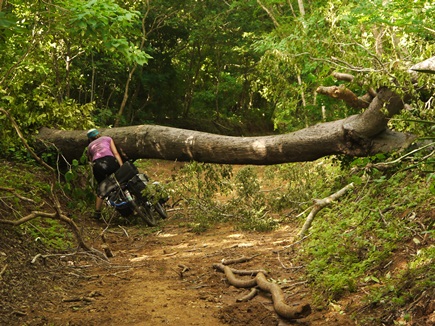
…and limbos trees just for fun. The question is – what happened to the all in one lycra suit? So far, all I've seen have been the shorts…
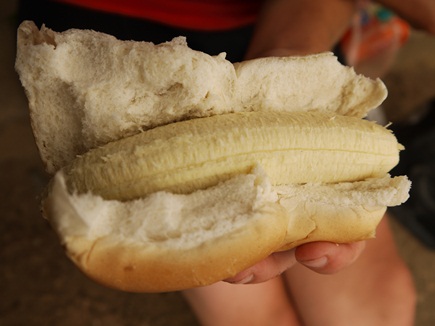
Bananas have taken centre-stage in our Central American diet. They're cheap, filling and – when added to a hot dog roll like this – distinctly gourmet.
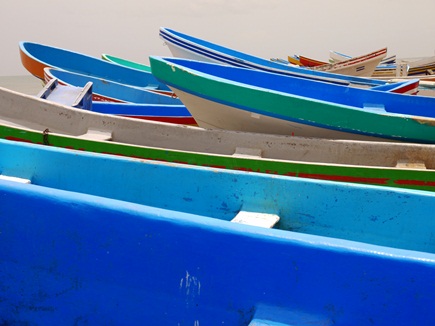
After popping out in La Trinidad, we hit tarmac again for an easy freewheel back down to the coast at Casares, the biggest fishing village along the coast. The boats were already hauled up out of the water for the day, and pigs snuffled amongst them looking for shade and scraps.
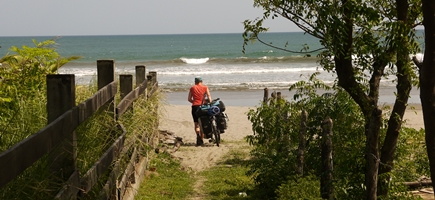
Beyond Huehuete, the “main highway” marked on our map came to an abrupt end – clearly the map makers' optimism exceeded the Nicaraguan government's funds when it came to road improvements. A quick consultation with some locals revealed that the beach was by far the best way to continue our route south – and this time we were in luck.
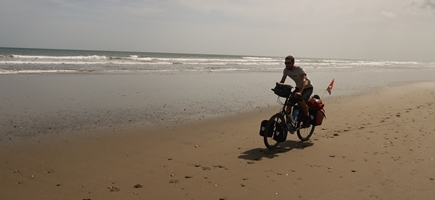
The tide was out, revealing a perfect highway of wet, hard-packed sand and a window of a couple of hours to reach the village of El Astillero 20km south, where we could rejoin the coastal road.
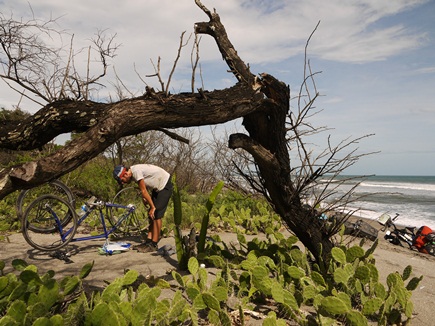
…SNAP! The metallic sound that every cyclist knows and dreads, and Sarah's first broken spoke of the trip. A quick beach repair and we were off again…then HISS! A puncture in the same wheel. Suddenly our window of time was looking very tight, and our water bottles almost empty. We decided to cut our losses for the day and find somewhere to camp.
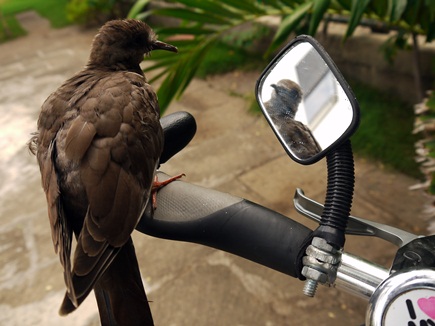
As always, it was a local to the rescue. Ramón was looking after one of the beachfront villas nearby and had watched us struggling with the wheel. He filled our bottles and invited us to camp. A dove provided the evening entertainment, preening itself in Sarah's mirror before attempting a bizarre and suicidal landing in our pan of boiling pasta.
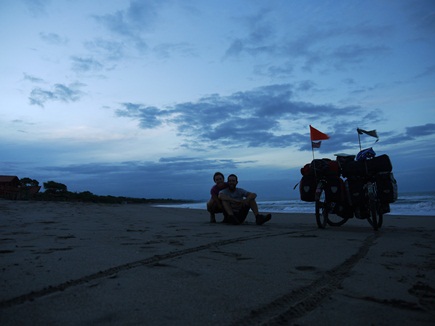
We were up at dawn, having worked out that we should have another window of time to ride the beach to El Astillero while the tide was out.
Some locals had beaten us to it, providing us with a perfect set of tyre tracks to follow. Squadrons of pelicans skimmed the waves just offshore, and hermit crabs scattered in front of us in every direction, racing to tuck themselves away inside their shells.
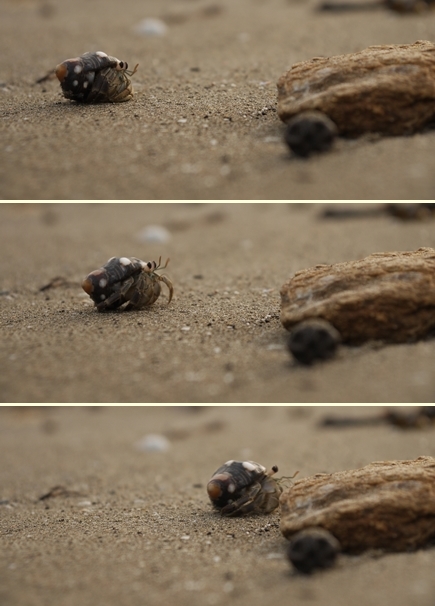
Stop for a minute though and they would nervously emerge: first, the eyes, like miniature periscopes; next a tentative claw; and finally, in a whir of legs, off they would scuttle.
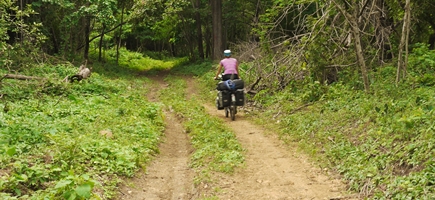
We made good progress for about 10km until just before Veracruz, where the beach once again became steeper and the sand deeper, swallowing our heavy bikes. We were stuck. Luckily some local fisherman were on hand to help us drag our bikes off the beach. They walked us inland and onto a beautiful track that they assured us would lead us south…
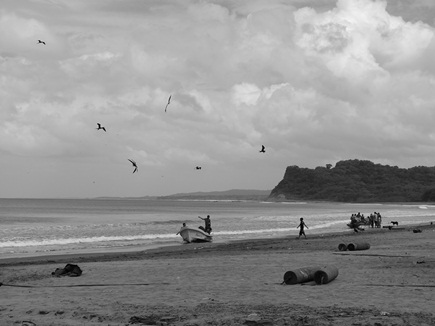
…which it indeed did. And so, 12 hours later than expected, we finally arrived in the fishing village of El Astillero – just as the morning catch was being brought in and sold along the beach.
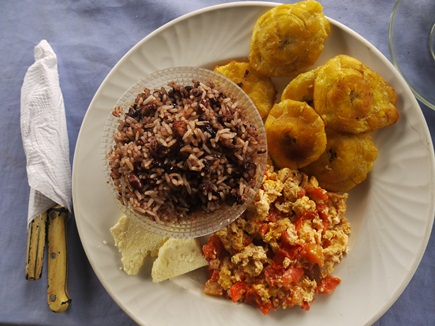
For me, there's only one meal better than breakfast – and that's second breakfast. We celebrated our beach ride with a typical Nica feast: gallo pinto (rice and beans cooked with herbs), tostones (fried plantains), scrambled eggs with tomato and onion and a slice of crumbly, fresh cheese.
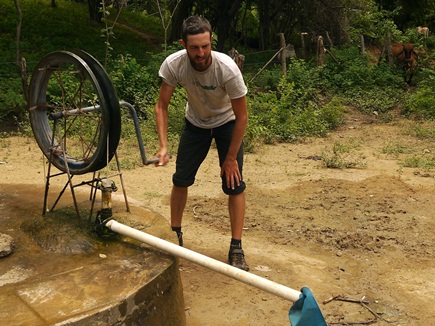
With our beach jaunt over for the time being, we turned inland again and headed across the narrow isthmus towards Lake Nicaragua, where we had planned a few days on Ometepe Island. First we stocked up on water from this ingenious bike wheel well…
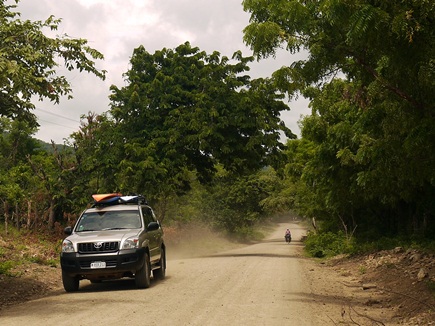
…before heading for Tola across a changing landscape. The roads became wider and faster, surfboards appeared strapped to flash 4x4s, and the signs suddenly all switched into English. We were clearly back in gringo holiday home territory.
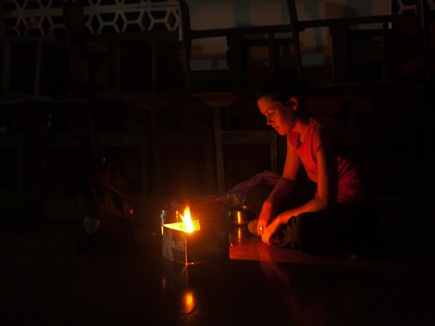
After a drowning in a mid-afternoon thunderstorm, we arrived in Rivas tired and soggy. Feeling cheap, we thought we'd try our luck at the local bomberos (fire station) – who sure enough were happy to let us fire up the stove and crash on their floor…
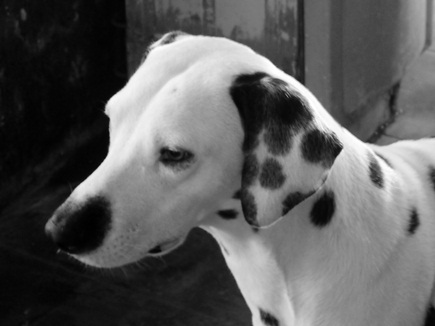
…all under the watchful eye of their dalmatian, Capitán. But we were more fascinated by a particularly memorable fireman, who our friend Andy had encountered and photographed when he stayed here a few weeks before. We wondered if we were in for a repeat performance, and sure enough…
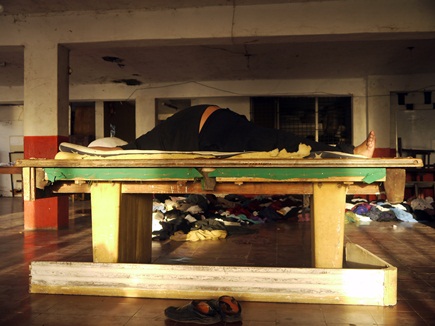
…here he is. Possibly the fattest fireman you'll ever see, snoring away peacefully on the pool table. It was all very Nicaraguan really – a flat green plain punctuated by a perfect volcanic cone. Apparently (and I'm not sure how this was physically possible), he actually shared the pool table with another guy when Andy was there – maybe since then they've had a falling out over one of them stealing the covers…
Isla de Ometepe
July 16th, 2012
It’s taken me a few years to admit it but I will finally state that boats and I just don’t agree. Being of a weak-stomached constitution, I get seasick at the slightest swell and usually feel a desperate urge to jump off and swim for the horizon. That all bodes well for the forthcoming FIVE day sailing trip between Panama and Columbia then…hmmm, let’s see how that pans out.
Nevertheless, I love islands and the boat journey that stood between me and Ometepe, nauseating as it was, didn’t put me off the tranquil wonders of this beautiful island on Lake Nicaragua. Perfect for cycling, being only 31km long and at its maximum only 10km wide, we were tempted by its two majestic volcanoes, and the prospect of some lakeside riding.
Sarah
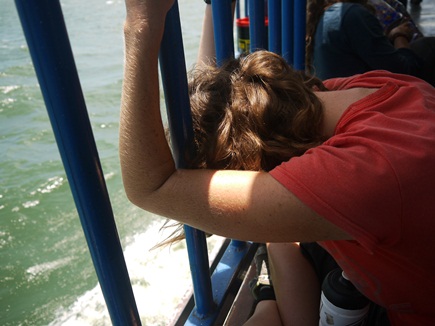
Hanging on for dear life, closing my eyes and thinking of England: all ineffective ways to ignore seasickness.
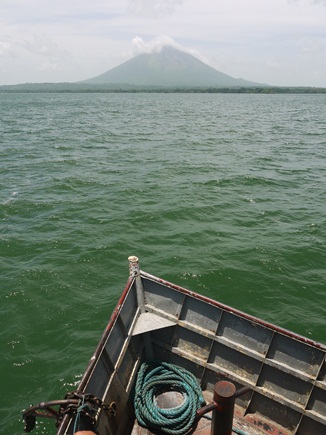
An hour later and the first of the island's two volcanoes came into view and I knew we were in for some picturesque riding.
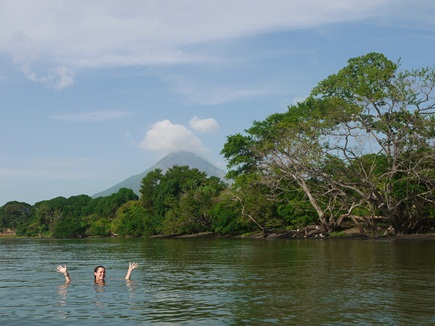
Shortly after arriving on the island, the seasickness having abated a little, we dipped into the lake and had the cool calm waters pretty much to ourselves.

Over the last year, we've got used to people stopping in their tracks to stare at us and the bikes as we trundle past – perhaps it's the lycra shorts – and these kids on the island were no different, seemingly oblivious to the beautiful backdrop, they stood open mouthed as we passed them by.
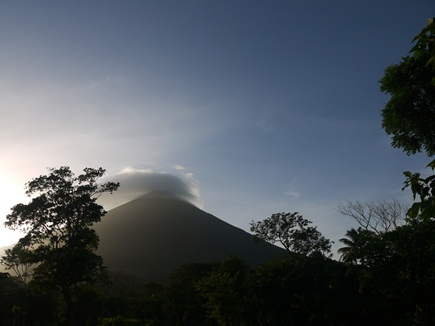
The sun starts to go down behind the bigger of the two volcanoes, Concepción, as we ride to our first destination. On the way we see howler monkeys, herons, hundreds of butterflies and hoardes of lush vegetation with stunning tropical flowers sprouting out of soil made fertile from volcanic ash. Apparently, Concepción is considered the “finest volcano cone” in Central America…high praise indeed.
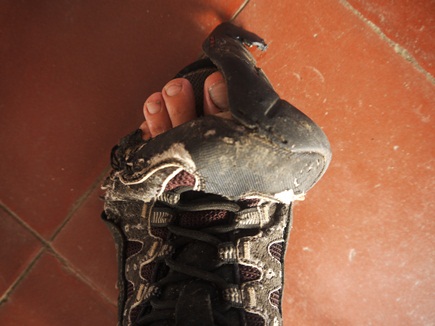
We might be in a Central American paradise, cycling past stunning natural wonders but the practicalities of the trip still have to be attended to. James' shoes suffer the consequences of too much Alaskan rain, a year of riding in all conditions and then the final nail in coffin was the hike up another volcano, Santiaguito in Guatemala, in May. With a new pair on order for collection in Panama City, these will have to make do until then, so out comes the duct tape…

Day two on the island saw us take a southern loop around the second, smaller volcano, Maderas. The road was dirt and pretty rocky at times through tiny villages and right along the lake.

Aside from James taking a dramatic head-first tumble into a rocky ditch like this one, it was the perfect Sunday afternoon ride.

We camped at Finca Magdalena, an organic coffee farm, and finished the day with hot strong Nicaraguan coffee and fried plantains with fresh mild cheese.
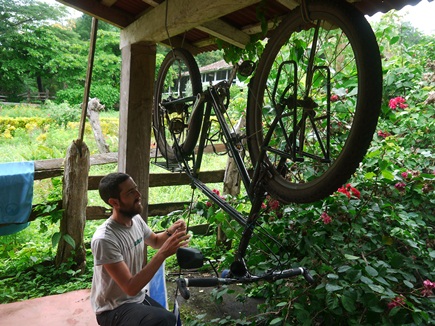
A relaxing third day was marred slightly when it began with a frustrating and sweaty hour tring to retrieve a pack of spare spokes that had been stored in James' seat post. With limited places to put things, we smugly thought that storing them here would be smart, until we realised that they'd slipped down further than we could reach and the only way to get them out was a “chopsticks” manoeuvre whilst the bike was hung upside down. And yes, we did receive some very curious looks from the staff and other guests at the finca.
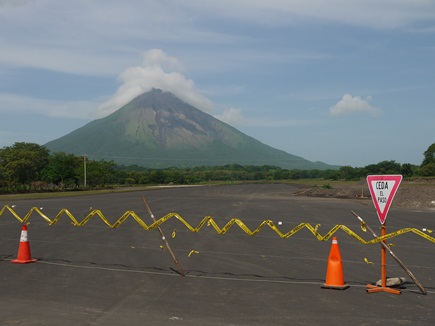
It's not the volcano cordoned off here – although Concepción is remarkably active, the last eruption being in 2010 – the taped area is the building site for an airstrip. If/when this becomes a reality, an influx of tourists by air looks likely to change the laid back unspoilt feel of the island.
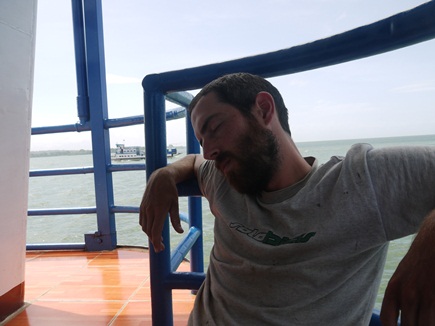
A rain shower and a night's camping at Charco Verde rounded off the trip and we headed for an early morning ferry to continue our route south through Nicaragua, hoping that we might catch up with some nesting turtles on the Pacific coast. It was a smoother journey back to the mainland but still, James copes with ferry crossings far more calmly than I do…maybe I'll try his snoozing technique next time we have to get on a boat.
Magical turtles
July 20th, 2012

One of only seven beaches where mass arrivals of nesting turtles occur, Reserva la Flor is a beautiful spot. As the sun goes down, we prepare to walk the beach and scan for turtles arriving to lay their eggs – over 100,000 of them use this beach to nest every year.
In the wrong place at the wrong time to see the migrating whales in Baja California back in November, we were determined not to miss a chance to see nesting turtles in Central America. So after Ometepe, we crossed back over to the Pacific coast of Nicaragua to visit Reserva La Flor. Olive Ridley turtles begin “arribadas”, mass arrivals, here in vast numbers in July so we were hoping to get lucky and see some ladies land on the beach to lay their eggs. A lovely dirt road ride took us from San Juan del Sur to Reserva la Flor, where a real treat lay in store for us.
The warden of the reserve waived our camping fee and only charged us half price to enter the reseve – he seemed shocked and amused when we showed up on bikes. We didn’t ask for any favours but it’s always so nice when someone warms to us simply because of the way we’re travelling. We spent the night camped outside the military dorms; they have a 24 hour military armed guard here to protect the turtles’ eggs from poachers.
Under a beautiful sky packed with stars, we are lucky to see an Olive Ridley turtle make her way back to the ocean having laid her eggs and another enormous Green Turtle, who also use the beach, in the process of nesting as we and other visitors look on. No flash photography is allowed as it disturbs the mothers so without the camera, we watch breathlessly as these amazing creatures follow their nesting patterns which haven’t changed for thousands of years.
There is no mass arrival on the night that we’re there but we feel privileged to have seen these two turtles at all. Little are we to know that the next morning, we’re in for another exceptional treat – this time with the beach to ourselves…
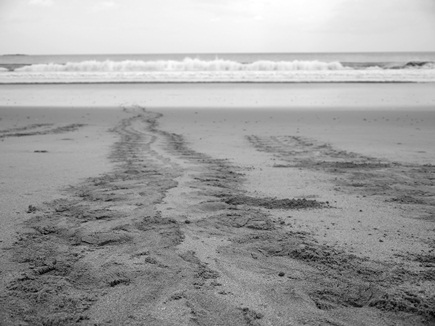
We wake at 6am to be told that during the night over 200 turtles came to lay eggs on the beach. We're in luck as the warden tells us to head straight to the beach where an Olive Ridley is making her nest in the daylight. Tell-tale tracks lead us to where the turtles have exited and returned to the ocean…

…and to the Olive Ridley who has begun digging her nest, under the watchful eye of one of the soldiers. These turtles take less than an hour to lay about 100 eggs and might come back a number of times during one season.

It's tiring work as the turtle has to dig out a hole in the sand deep enough to hold her eggs with just her flippers. She stops every few moments to take a deep breath and lets out a weary sigh before carrying on. She looks for all the world like she'd really rather be doing something else.
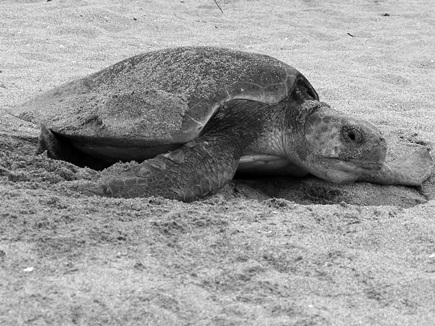
Now she has laid the eggs, it is time to cover them over and pack them down to give them the best chance. The turtle launches herself up and down onto the sand to pack it down making an odd thumping sound and looking most ungainly. These creatures are so much more graceful once in the water.

And the result of her labour of love: a nest of disturbed sand. It will be 50-60 days before the eggs are ready and then the babies will hatch all at once to ensure a greater chance of survival. If they survive the dash into the ocean (and are not defeated by sun, predators, poachers or dehydration first) they will travel as far as Alaska and Chile before the females return here to nest as their mothers have done.
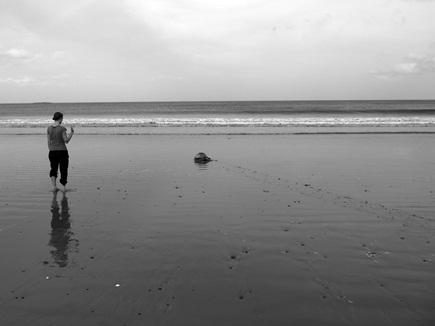
… while I follow behind to wave her off, pinching myself at how lucky we were to have witnessed this fascinating and humbling ritual.
Sarah
